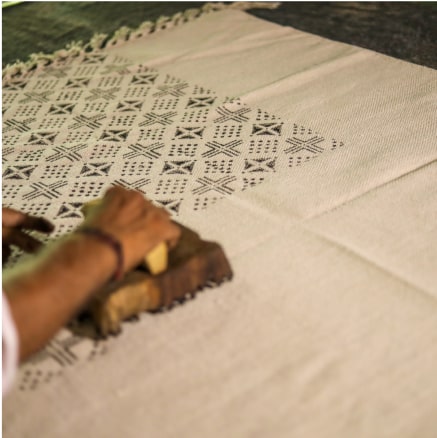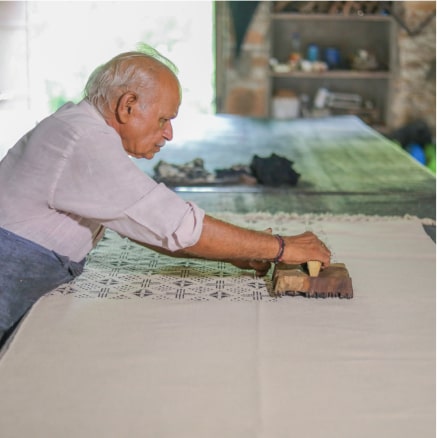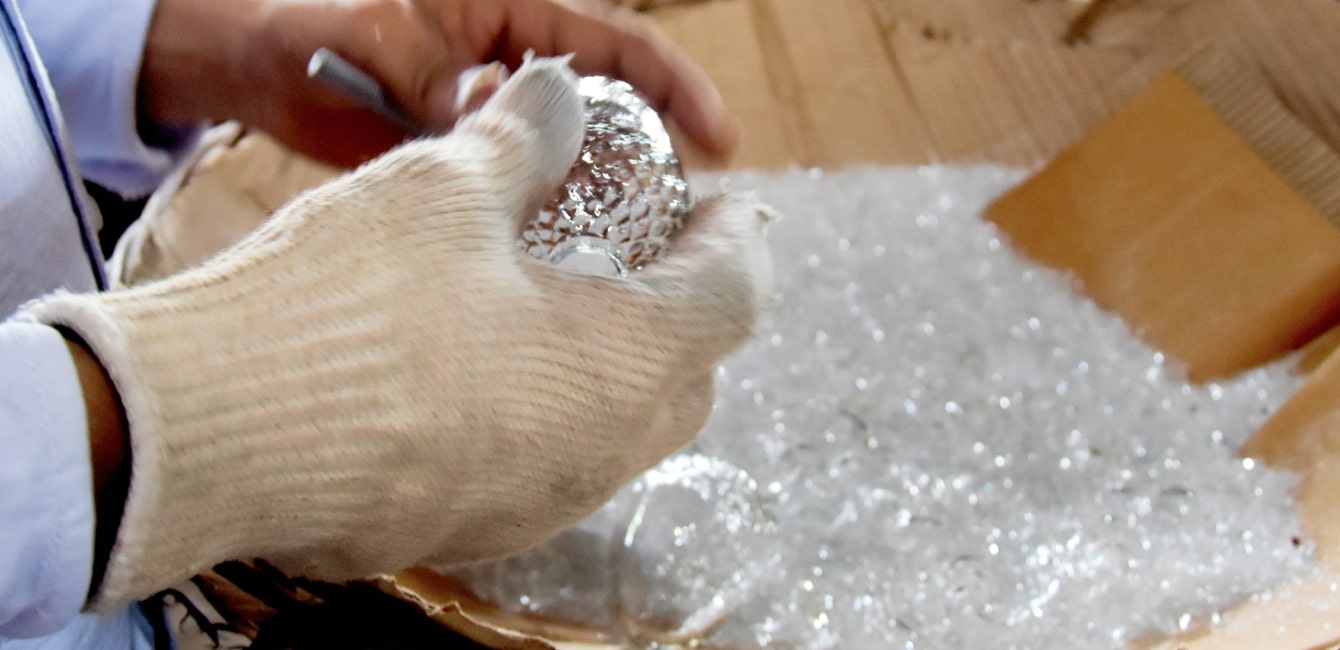HISTORY OF BLOCK PRINTING
BLOCK PRINTING ON FABRIC
THE PROCESS OF BLOCK PRINTING ON FABRIC
WHAT FABRICS ARE USED FOR BLOCK PRINTING
OTHER STYLES OF BLOCK PRINTING
CONCLUSION
What Is Block Printing
Block printing involves carving an image or design into a block of wood, inking the block, and then pressing the inked block onto paper.
The artists carved block can then be reused many times, making block printing a very efficient printing technique.
Block printing has been used for centuries to create everything from books and newspapers to fabric and wallpaper. Even many famous artists have used block printing to create their work, including Albrecht Dürer, Pablo Picasso, and Jasper Johns.
Block printing can be a great way to add a personal touch to your work or to add a unique and beautiful style to your home decor.

You might not realise it, but block printing is a common sight in many homes. You will often see this technique on items such as: Throws, Cushion covers, Blankets, Upholstery, Quilts, Duvet Covers, Table napkins, Lino prints, Dresses & skirts.
History Of Block Printing
Block printing is one of the oldest forms of printing and has a long and varied history. This ancient is believed to have originated in China in the 3rd century, and before being used on fabric and textiles, block printing was actually used as text on paper. The earliest known dated block print is the Diamond Sutra, dated from 868 AD.
In the 4th century, it found popularity in Egypt & Asia, where it spread to Europe and the rest of the world. In medieval times, when people made their own clothes and household items, they would carve out designs into wooden blocks and then print them onto their garments. When block prints arrived in India it started to undergo many developments and soon saw India as the central hub of block printing.
Rajasthan had a large textile production community, and cotton printing and dyeing was one of the state's specialties. Gujarat also became a major center for printed fabrics, using special blocks to create intricate designs. Today, both states continue to be important players in India's textile industry, producing some of the finest block printing fabrics in the world. Here at Mytri Designs, we work specifically with artisans who specialise in the block printing technique, using methods passed down from family to family through generations.
Block Printing On Fabric
Here at Mytri Designs, our artisans specialise in block printing on fabric.
All of our designs are sourced from Indian artisans, as India is a renowned source of fine artisan fabric block printing patterns. The community of Jaipur has become pretty much the hub of block printing on fabric.
India has a long history of block printing on fabric, which has led to the development of a wide range of specialized dyes, fabrics and patterns, and are a place of pride for many artists.


The process of block printing on fabric involves:
Designing the print:
Some people like to use digital tools for this one such as photoshop to ensure the design is pretty much perfect, but more skilled artisans can do this with ease using just a pencil.
There are two approaches to this, either first draw the design onto a piece of paper then trace it on to the wooden block, or just go straight to the block and start the drawing there.
Carve the wood:
Once the drawing is complete on the block its time to start carving. This is the most time consuming part of the process and absolutely the most important!
The drawing is intricately carved using a gouge blade or whittle knife.
The focus here to to remove the parts that won’t be printed, so the excess wood is where the ink or dye will stick to create the final pattern.
Mounting the wood block on to a handle:
This is optional, as some artisans can use the base of the block, but there can be more precision found using a handle on top of the block. The handle will need to have a flat top as this is where the artisan will press down when inking the fabric.
Dipping the block into non-toxic ink or dye:
The ink or dye is added on to a flat surface so the block can be dipped gently in until it is evenly applied.
Hand stamping the block on to fabric to create the pattern:
Once the block is inked it is time to start stamping on the patterns.
A test stamp is usually carried out on a small piece of fabric to ensure the block design is as it should be. If it is evened out and the pattern and perfected the artisan will move on to the final fabric and gently stamp on the patterns using the palm of their hand to get just enough force on the top of the wooden block.
The process of creating the block is generally done completely by hand, and no 2 prints are ever the same.











What Fabrics Are Used For Block Printing
The fabric used for block printing must be of good quality, because it reflects on the printing quality. The choice of fabric will obviously depend on the final product, but there are several fabric types for block printing, but most artists prefer cotton, linen, hemp, silk, and wool. Cotton is the preferred choice as it is soft, thin, and easy to use. But the best fabric for block printing is linen. Linen fabric is soft, thin, and easy to print. Moreover, linen fabric is durable and will not shrink after printing.
Here at Mytri Designs, our artisans prefer cotton for our cushion covers & throws, as we want the final product to feel luxurious and comfortable for any home.
Other Styles Of Block Printing
For block printing there are many other different styles and techniques used making each one quite unique based on its origin.
Some of the the other more popular techniques are:
Woodcut printing
This is the one of the oldest type of block printing. Here, the images are carved into fruit woods such as mango, pear, cherry, as these types of lighter woods can maintain a higher level of detail.
Japanese Ukiyo-e woodblock printing
Ukiyo-e is an art form that uses woodblock printing to create images of the daily life of the common people. These prints are usually made to be sold to the public in the form of postcards, calendars, and other small items. They can be very simple, or they can be elaborate and detailed, and often look like watercolour paintings or sometimes modern manga.
Linoleum block printing
This is the same technique as wood block printing, but with linoleum blocks as the base. The printing process that involves carving a design into a block of linoleum, inking the block, and then pressing it onto paper.
Reduction printing
Reduction printing is a printing process where each successive color is printed from the same block, or from a reduced version of the block. This printing technique can be used to create a variety of images, from detailed line work to more abstract images. This method was incredibly popular with many artists, and was popularized by Pablo Picasso in the 1950’s.
Rubber stamping
It’s also possible to use a form of rubber stamping instead of block printing. The same principles and techniques apply, except instead of wood a rubber carving is used. It’s very easy to carve compared to wood and still capable of similar details, so it is more of a beginners step into the world of block printing.
Conclusion
Now that you know a little bit about block printing you might start to notice it more and more in designs next time you are out shopping.
If you want to check out some of our expert block printed fabrics you can have a browse in our throw and cushion cover collections to see this fine art on display.

Our Values
FIND OUT MOREExplore Other Craft Techniques

Block Printing
Block printing is the process of printing patterns by means of engraved wooden blocks. It is the earliest, simplest and slowest of all methods of textile printing....
FIND OUT MORE
Glass Bauble Making
Let's take a look at the techniques used and equipment needed to create these beautiful pieces of art, and the artisans who have made it their life’s work...
FIND OUT MORE




